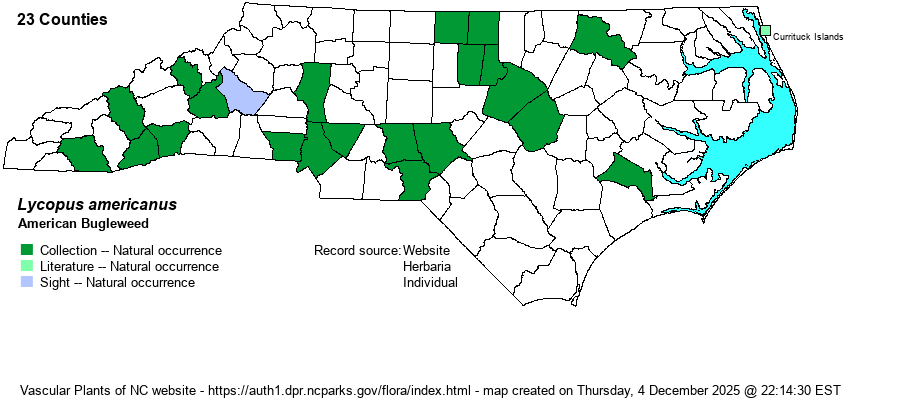| Author | Muhlenberg ex W.P.C. Barton | |
| Distribution | Widely scattered in the Piedmont and Mountains, with a disjunct record in Jones County in the eastern Coastal Plain, and on the Currituck County Outer Banks. Large areas lacking records in the Mountains and northwestern Piedmont, but not known if real absence or not.
This is a very widespread species across North America, but it is scarce in the southeastern states from NC southward. It ranges south to the FL Panhandle and TX.
| |
| Abundance | Rare to uncommon in the Piedmont, certainly overlooked, but relatively few collections and observations, especially in relation to it being widespread and frequent throughout VA. Rare in the Mountains, and essentially only at low elevations. Extremely rare in the Coastal Plain, recorded only from Jones County. At any rate, there is a real drop in numbers of this "common" species southward from VA and TN. Even Weakley's (2018) map shows it as "rare" in all three provinces in NC. In late 2024, the NCNHP moved the species to the Watch List, at the suggestion of the website editors. | |
| Habitat | This species occurs in damp places, typically in marshes, openings in bottomlands, and wet meadows. IN NC, it seems to be more of a plant of high pH soils, even occurring on rich slopes. This seeming affinity for higher pH soils in NC may account for its scarcity. | |
| Phenology | Blooms from June to frost, and fruits shortly after flowering. | |
| Identification | Though one of the more common wetland species in the northern half of the U.S., being the most numerous member of the genus in such places, it is unfamiliar to most NC biologists. Like most others in the genus, it is a slender, unbranched herb growing to 1-2 feet tall, with numerous opposite leaves, and tiny white flowers in most leaf axils. This species is identified by the narrowly elliptical or lanceolate leaves, about 2 inches long, that have deeply cut, pinnate lobes, with each lobe or tooth at least 5 mm (1/5-inch) long. All other native Lycopus species in NC have leaves with some serrations, but with the teeth quite tiny. As mentioned above, for whatever reason, not owing to scarcity of suitable habitat, the species is remarkably scarce in NC and states to the south, with a sharp drop-off in abundance south of VA. | |
| Taxonomic Comments | Not surprisingly, owing to its very wide range, many references give varieties. However, Weakley (2018) does not.
| |
| Other Common Name(s) | American Water-horehound. Practically all members of the genus are also known as water-horehounds. This and many other references prefer "bugleweed" as the common name for the genus. | |
| State Rank | S2 | |
| Global Rank | G5 | |
| State Status | W7 | |
| US Status | | |
| USACE-agcp | OBL link |
| USACE-emp | OBL link |

